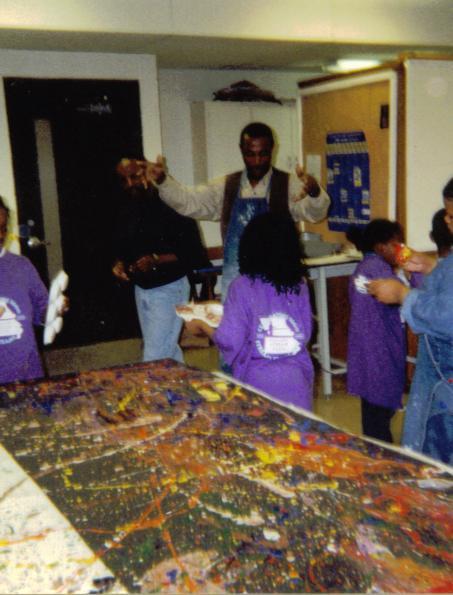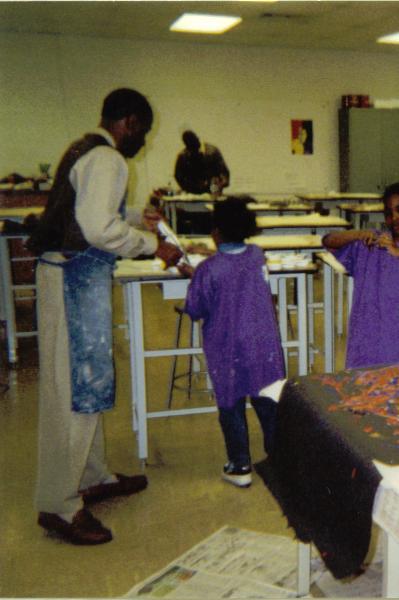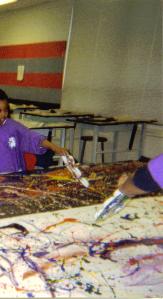 Shop On-Line at the Art of Essex
Shop On-Line at the Art of Essex
 Shop On-Line at the Art of Essex
Shop On-Line at the Art of Essex
|
|
Lesson Plan Jackson Pollock
Study In Creative Thinking |
Student Teacher: Essex Garner,
Lincoln
University, Jefferson City, Missouri,
In cooperation with Lincoln University and the Boys and Girls Club, Dr. Clifton
Pearson, Instructor (EDU 203) 1999
Unit: Constructivist and Abstract Thinking
Grade Level: Elementary (3
through 8 Grades) Adaptable to higher grades
Objective
Demonstrate and teach students a new creative thinking process in art through
the techniques of the Action Painter (Jackson Pollock) i.e. while listening to
Jazz. Expand on the students intrinsic interpretations and to facilitate
divergent thinking while working together in a
constructivist environment (Constructivist Learning).
|
Strand: Enjoying Art, Making Art, Art Appreciation and Music
Appreciation. Supplies Needed Black or White construction paper (role paper preferably), tempera paint, brushes, small plastic containers for drip technique, protective clothing, scissors, drop cloth if done indoors and Music (Bob James) works best for me. Drop cloth, string and a picture frame. Introduction: Discuss the abstract "Action Painter" Jackson Pollock and others within this art movement; William de Kooning, Lee Krashner, ect. Discuss the indigenous Jazz movement in America (Charlie Parker, Dizzy Gillespie, etc; tie together the importance that neither of these two art forms were copied (both were and are original concepts). (Note: reframe from music with lyrics, these can be suggestive and or leading in creativity). Show examples of Pollock's work (Black and White or Lavender Mist, etc.). This lesson is appropriate for the disable child. |
 |
 |
Key Concepts-Goals:
(1) Students experience working as a collective and individually in this abstract format. |
Step 1. Cover area for painting with either news paper or drop cloth (indoors or out). These are only your best behaved students. Respect of others during the painting process is immanent. Separate colors into containers for painting. Step 2. Role paper over drop cloth area either onto a table or the floor. White or black or both. White or black construction paper adds for higher contrast. (Start your music). Emphasis the importance of the feeling in the music to gestured movements. Here is why lyrics could predisposition this creative process, not to be led (Bach) could work as well.
Step 3.
Have students
under controlled advise start manipulating one color at a time to the
surface area. At this point string dipped generously into paint and moved
across the paper works for me very well. This is a very controllable
technique. Insure that all students work on more than one section or part of
the paper. If your using multiple background colors for negative space
insure all students work on both section or all sections. |
 |
Day 2: After the paintings have dried
completely, introduce the picture frame.
Step 6.
Sense the
students worked as a collective on the painting, there is no ownership. The whole thing belongs to them. Have the students select an
area
of the painting either the black or white and place the picture frame
around an
area that appeals to them. |
Vocabulary:
Action Painting, Jackson Pollock, Jazz, drip technique, abstract, Black and
White/ Lavender Mist, Charlie Parker, Dizzy Gillespie, William de Kooning, Lee Krashner,
freedom of expression,
negative space, and picture frame.
Recommended
Web Resources:
1.
Guggenheim Collection - Artist - Pollock -
Biography
2.
Pollock-Krasner Foundation,
Jackson Pollock
3.
Charlie Parker (Frank Driggs Collection);
http://www.pbs.org/jazz/biography/artist_id_parker_charlie.htm
|
|
   |